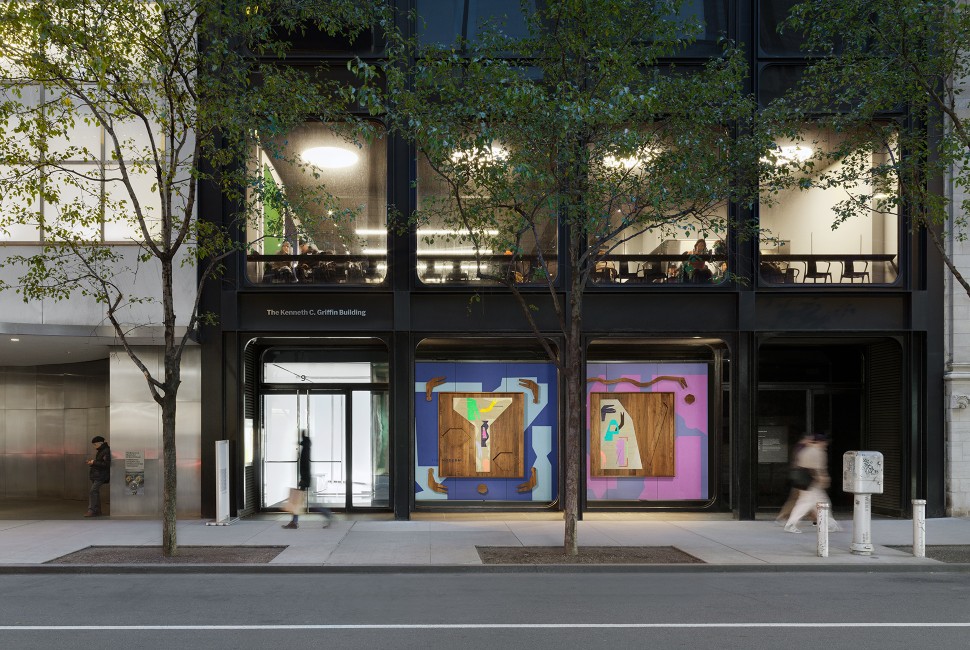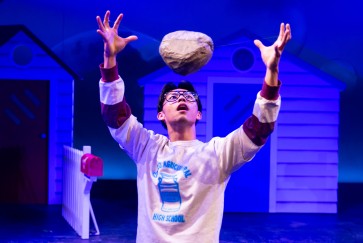Caroline Kent’s artistic practice is about language, often mysterious and sometimes unspoken.
The sound of a brush moving across canvas could be heard as Kent spoke to Northwestern Now from her studio about her exhibition at The Modern Window at MoMA.
“When I’m given the opportunity to work in a space that is a part of an existing architecture, it’s always a challenge — but also a moment of discovery for all involved,” she said.
Kent spent years painting on paper and canvas as she developed a visual language of abstract shapes and color and discovered the borders of that language. A twin, Kent is fascinated by the shorthand communication between people who are kin and close, but says that coded language can take place between any two intimates.
Kent’s installations have become increasingly multidimensional, with shapes emerging from walls, and sculptures and furniture pieces placed within the exhibition space, such as her recent solo exhibition at MCA Chicago.
“With each project, the prompts and situation change, which switches the conditions in which the language is operating,” Kent said. “It makes sense with my practice that the language can move from the canvas to the room and be performed by the body. Painters have collaborated with performers for a long time.”
The architecture of MoMA’s exterior windows provides a theatrical setting for Kent’s work. The lit-up windows make the work available to the public at all hours — even at night when the museum is closed.
A pair of 6-foot-wide by 8-foot-high paintings of richly colored geometric shapes are fitted into inlaid wood. Each work is distinct yet in harmonic conversation with the other.
Comprised of walnut, unprimed Belgian linen and acrylic paint, Kent worked with a fabricator to create the large wooden frame and inlaid canvas. They are the largest and heaviest works of this type she has created to date.
“A challenge of working in this context was the reflective nature of the windows,” Kent said. “But the forms and presentation are strong, so although it takes a moment for the eye to adjust, nothing is lost in this setting.”
Passersby can watch the silent play of cryptic communication between the windows now through Oct. 15. Perhaps they are even part of the performance.
Far from comprehensive, this brief roundup highlights other recent projects by faculty artists who are practicing what they teach. Read about other recent faculty projects and emerging trends in the arts.
Marco Williams explores the trauma of gun violence
Documentary filmmaker Marco Williams tells American stories through the lens of the Black American experience. His work aims to highlight injustices as well as the efforts of those working to make a difference.

The idea for his current project, “Murders that Matter,” took root in 2014 after the killings of Michael Brown and Eric Garner by police officers prompted widespread societal outrage. Williams wanted to shed light on the killings in the Black community, often by other Black people, that were not being talked about.
He chose Philadelphia as a site because at the time it had more unsolved murder cases in the Black community than any other city. He was also drawn to it because two of his relatives had been murdered in Philadelphia.
Williams told Northwestern Now that over the course of working on the film, he discovered that the film was as much about trauma as about gun violence in the Black community.
So, what makes this story relevant to audiences today?
“My answer to this question is a series of questions,” he said. “What if a major part of your life’s narrative was shaped by the murder of the people you love? Your father, your brother, your cousin, your son. What would you do? Would you purchase a gun? Would you start a family foundation? Would you run for political office? How would you manage the trauma?”
“Murders that Matter” premieres Oct. 2 as part of the PBS documentary series “POV.”
From 19th-century Russia, with a race dimension
Thomas Bradshaw has frequently adapted written work for the stage. His play “Southern Promises” is a loose adaptation of slave narratives and “JOB” was based on the biblical story. But Bradshaw’s adaptation of Chekov’s “The Seagull” marks the first time he adapted a play written in another period for a modern audience. He relocates Chekov’s group of suffering theater artists from the 19th-century Russian countryside to the 21st-century Catskills and adds the dimension of race to the play’s love triangles.
“The Seagull/Woodstock, NY,” produced by The New Group and starring Parker Posey, ran Off-Broadway Feb. 7 to April 9.
When asked what attracted him to the project, he said, “I’ve been teaching Chekov for almost 20 years, so I was excited to take this on. Chekov simultaneously has deep empathy for his characters, yet gently makes fun of them at the same time. He shows us that hypocrisy is a natural part of the human condition and that the answers to our problems are often right in front of us, yet we’re often incapable of seeing that. I wanted to create a version that mined the comedy, since that is not the way audiences normally think of Chekov.
“As a Black man, I also wanted to create a version that reflects the complexity and diversity of contemporary America. I wanted this version to speak to the racial, political and sexual realities of the world that we live in, all while staying true to Chekov’s original intentions.”


